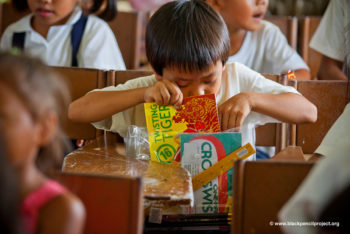Books for Babuyan Islands (Part 1 of 2)

Black Pencil Project study packs
He was born without a left leg, and his right foot does not have a leg, just a foot sticking out of his right pelvis. Living in a sitio at the foot of Mount Camiguin, some five kilometers away from his school, he goes to school daily on a carabao together with his two siblings and their mother. He dreams of becoming a doctor.
We met again when I came back to Camiguin Norte for an outreach mission last March 18. The grade six pupils of Cadadalman Elementary School were due to graduate and Ricky was in the top 10 of the graduating class.
With Ricky as one of our inspirations, our group of 19 volunteers set out on a mission to help provide school supplies to about 1,500 school children from four elementary schools situated in the island of Camiguin Norte, one of the five islands of Babuyan Islands.
Why Camiguin Norte?
The place has a population of approximately 5,000, mostly fishermen or farmers. There are no hospitals or doctors on the island; no public markets, no post office, no funeral parlors, limited supply of electricity, and only a few motorcycles and bicycles. About half of its population live in poverty.
Our mission—a collaboration between the Dominican Missions and Black Pencil Project—was called “Project Aral, Silid Aklatan.”
I first met Mon Corpuz, Black Pencil Project founder, when I was parish priest in the island. The Babuyan group of islands being home to several species of dolphins and a migration destination of humpback whales every summer, a whale watching expedition with a group of mountaineers and photographers in the summer of 2009 brought him to Camiguin Norte. In fact, the story of a pencil equally divided into three pieces by a teacher so that three children would be able to write came from this community and inspired Black Pencil Project’s advocacy.
Meanwhile, the idea to set up a library in Morol Elementary School came from artist AG Saño, also a wildlife and environment conservation advocate, and who like me, is a member of Black Pencil Project’s core group. He has been visiting the island annually for 15 years now, initially as a whale researcher and photographer for World Wildlife Fund for Nature (WWF), and eventually Black Pencil volunteer.
With the help of the project website, www.blackpencilproject.org and social media, we managed to gather donations to carry out our mission. A three-minute video entitled “Books for Babuyan” made by volunteers explained the project’s purpose. Radio station DZBB also boosted our fund raising efforts.


No Comments